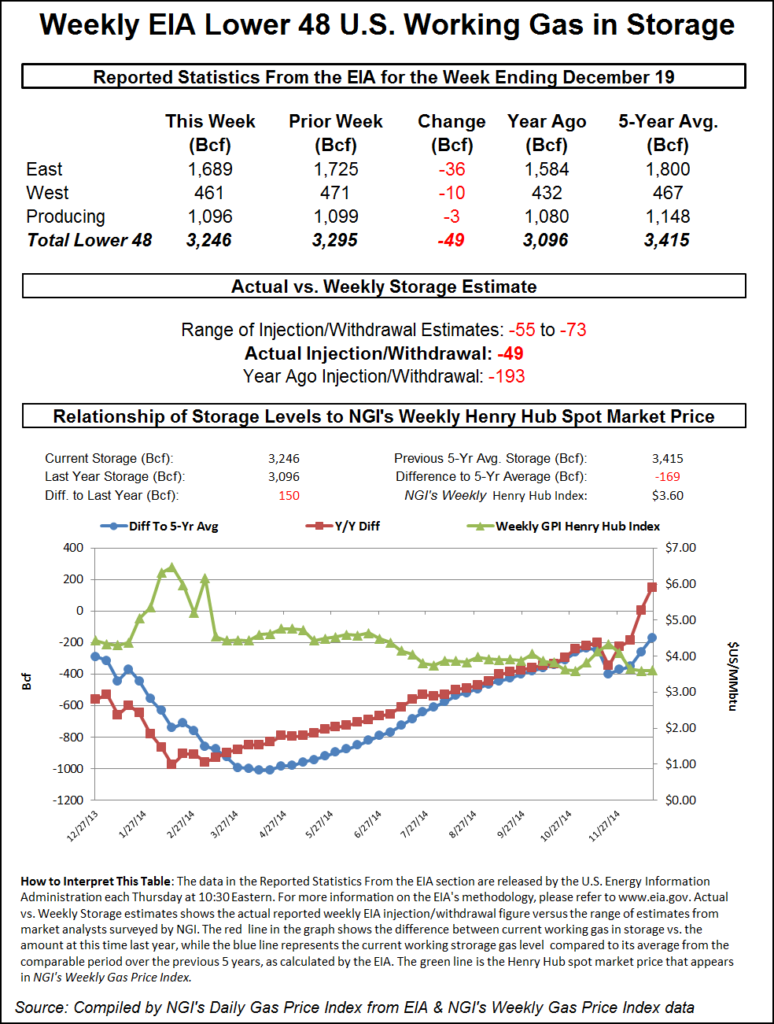NGI Data | Markets | NGI All News Access
Western Points Lead Overall NatGas Market Gain; Futures Breach $2
Natural gas for delivery over the extended holiday period posted gains in Thursday’s trading as strong weather-driven gains in the Rockies and California were able to outperform softer points more aligned with the Henry Hub.

The NGI National Spot Gas Average gained 3 cents to $1.56. Losses of close to a dime at the Henry Hub were countered by double-digit advances at western points. Futures hurdled the $2 bar as the Energy Information Administration (EIA) reported a relatively hefty 32 Bcf withdrawal, about 7 Bcf more than what the market was expecting. January futures added 4.6 cents to $2.029 and February rose 4.3 cents to $2.079. February crude oil tacked on 60 cents to $38.10/bbl.
The bigger-than-expected storage withdrawal put inventories at 3,814 Bcf and January futures rose to a high of $2.040, but by 10:45 a.m. EST January was trading at $2.011, up 2.8 cents from Wednesday’s settlement.
Prior to the release of the data, analyst estimates were in the 25 Bcf withdrawal area. Tradition Energy was looking for a pull of 30 Bcf, and a Reuters poll of 22 traders and analysts showed a range from -13 Bcf to -38 Bcf, with an average -25 Bcf. IAF Advisors calculated a 21 Bcf withdrawal.
On paper the reported storage pull looked supportive, but little change was noted in burdensome inventory levels. “The 32 Bcf net withdrawal from US natural gas storage was more than expectations and so supportive for prices, even though this was still a very small pull from storage for this time of year, far below the 121 Bcf five-year average level,” said Tim Evans of Citi Futures Perspective. “We don’t know what’s behind the miss, but it’s possible that either natural gas has picked up some power sector demand via coal-to-gas switching at the lower price levels or that some supply was shut in. In any case, the draw for last week confirms a modestly tighter balance compared with recent flows.”
Inventories now stand at 3,814 Bcf and are 561 Bcf greater than last year and 471 Bcf more than the five-year average. In the East Region nothing was pulled, and the Midwest Region saw inventories fall by 15 Bcf. Stocks in the Mountain Region fell by 5 Bcf, and the Pacific Region was down 15 Bcf. The South Central Region, similar to the former Producing Region, added 3 Bcf.
Traders see the current emphasis on weather forecasts diminishing once the market begins focusing on the post-holiday period. As is the case in the liquids, we feel that this week’s price rebound is being accentuated by a thin holiday related trade,” said Jim Ritterbusch of Ritterbusch and Associates in a note to clients. “While conceding to some shifts in the temperature views spread mainly across the first week of January, we are still not seeing any cold patterns on the horizon capable of making a significant dent in a large supply overhang. However, we will concede to a significant strengthening in the front switch this week in which the Jan-Feb differential has been more than halved from around 12 cents to less than 5 cents with the approach of Tuesday’s expiration.
“Although much winter lies ahead, we expect the impact of daily shifts in the weather forecasts to lessen after the New year as heavy focus will continue to be placed on a large season ending supply north of the 2.4 Tcf level in our opinion. We are maintaining a bearish stance for now as we have suggested fresh shorts north of the $2 mark per February futures. Stops would be advised above the $2.21 level on a close only basis. And although we may be forced to adjust our ultimate downside target of $1.61 upward to this month’s January contract lows of $1.68, risk-reward of more than two to one still appears accommodative toward new short holdings.”
In physical market trading, western points vaulted past the Henry Hub as a western storm system began a march eastward. AccuWeather.com forecast that Denver’s high Thursday of 39 degrees would drop to 32 Friday and a chilly 19 by Saturday. The normal high in Denver is 32 in late December. Los Angeles’ high for Thursday of 63 would slide to 60 by Friday and 59 Saturday, eight degrees below normal.
Gas at Cheyenne rose a penny to $1.64, but quotes on Kern River jumped 19 cents to $2.21. At Opal extended weekend packages were quoted 20 cents higher at $2.23, and parcels on Northwest Northwest Sumas changed hands 22cents higher at $2.30.
Deliveries to Malin were seen 20 cents higher at $2.30 and at the PG&E Citygate gas was quoted up 7 cents to $2.54. Gas at the SoCal Citygate was seen 8 cents higher at $2.58, and the SoCal Border Avg. Average jumped 17 cents to $2.26.
Gas at the Henry Hub dropped 8 cents to $1.54.
AccuWeather.com meteorologists reported that “The last storm in a long train of systems from the Pacific Ocean will drop southward along the Pacific Coast, while spreading precipitation inland to end this week. The storm will put plenty of fresh powder down in the Sierra Nevada, as a Christmas present for skiers and boarders, but the storm will bring its share of problems for holiday travelers,” said meteorologist Ken Clark,
“The southward-tracking storm will pull cold air with it and result in low snow levels from Washington to Southern California, as well as areas well inland over the West. Cold weather will have much of the West in its grasp with areas of snow into Christmas Day,” Clark said.
© 2024 Natural Gas Intelligence. All rights reserved.
ISSN © 1532-1231 | ISSN © 2577-9877 |
